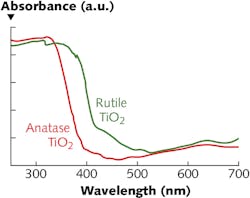UV photodetector with TiO2 monolayer has high responsivity
For detection of ultraviolet (UV) light, wide-bandgap semiconductors, such as zinc oxide (ZnO), silicon carbide (SiC), and titanium dioxide (TiO2), are especially well suited because of the location of their bandgap in or near the UV spectrum. The detection efficiencies of these materials in the UV can be drastically improved with nanostructuring of various types. A group at Hanyang University (Seoul, South Korea) has come up with an effective configuration for nanostructured TiO2 for UV photodetection made of hollow TiO2 nanospheres on p-type gallium nitride (GaN).
The researchers fabricated TiO2-based photodetectors by creating an n-TiO2 sphere monolayer film on a polydimethylsiloxane (PDMS) supporting plate—the monolayer was then transferred to a p-GaN based p-n junction structure. The hollow TiO2 spheres were about 350 nm in diameter and were positioned into monolayers (before transferring) using a rubbing method. Electrodes consisted of an indium layer on the GaN substrate and a layer of indium tin oxide (ITO) formed on glass and placed on the monolayer. The researchers tested two forms of TiO2: anastase, and rutile. The researchers found that the anastase TiO2 monolayer/p-GaN junction performed better than a p-n junction based on a rutile TiO2 monolayer because of the faster electron transport in the anastase. The responsivities for the two materials were 0.203 A/W at 312 nm for anastase and 0.093 A/W at 327 nm for rutile. Reference: T. Wang et al., Opt. Express (2017); https://doi.org/10.1364/.25.030843.

John Wallace | Senior Technical Editor (1998-2022)
John Wallace was with Laser Focus World for nearly 25 years, retiring in late June 2022. He obtained a bachelor's degree in mechanical engineering and physics at Rutgers University and a master's in optical engineering at the University of Rochester. Before becoming an editor, John worked as an engineer at RCA, Exxon, Eastman Kodak, and GCA Corporation.
